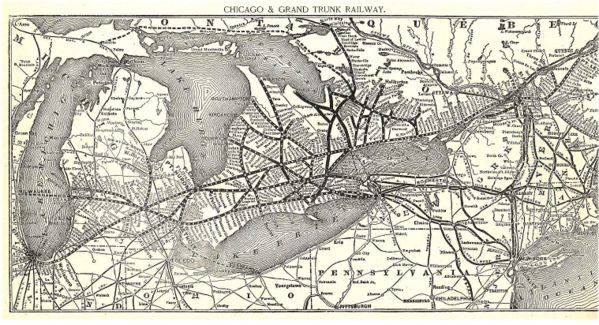Grand Trunk Railway: Difference between revisions
imported>Subpagination Bot m (Add {{subpages}} and remove any categories (details)) |
imported>Gareth Leng (→Bibliography: to subpage) |
||
| Line 9: | Line 9: | ||
American executive Charles Melville Hays (1856-1914) joined the Grand Trunk in 1895 as general manager (and in 1909, president, based in Montreal). Hays was the architect of the great expansion during a colorful and free-spending era. He upgraded the tracks, bridges, shops and rolling stock, but was best known for building huge grain elevators and elaborate tourist hotels such as the Chateau Laurier in Ottawa. Hays blundered in 1903 by building a subsidiary the '''Grand Trunk Pacific Railway Company''' some 4800 km long; it reached Prince Rupert in northern British Columbia in 1914. The government built and the Grand Trunk operated the National Transcontinental to link the main Grand Trunk with its Pacific subsidiary. The very expensive subsidiary was far north of major population centers and had too little traffic. Nearing bankruptcy in 1919, the entire system was nationalized, In 1923 the government merged the Grand Trunk, the Grand Trunk Pacific, the Canadian Northern and the National Transcontinental lines into the new '''Canadian National Railways'''. The Grand Trunk lines, however, kept its distinctive name. | American executive Charles Melville Hays (1856-1914) joined the Grand Trunk in 1895 as general manager (and in 1909, president, based in Montreal). Hays was the architect of the great expansion during a colorful and free-spending era. He upgraded the tracks, bridges, shops and rolling stock, but was best known for building huge grain elevators and elaborate tourist hotels such as the Chateau Laurier in Ottawa. Hays blundered in 1903 by building a subsidiary the '''Grand Trunk Pacific Railway Company''' some 4800 km long; it reached Prince Rupert in northern British Columbia in 1914. The government built and the Grand Trunk operated the National Transcontinental to link the main Grand Trunk with its Pacific subsidiary. The very expensive subsidiary was far north of major population centers and had too little traffic. Nearing bankruptcy in 1919, the entire system was nationalized, In 1923 the government merged the Grand Trunk, the Grand Trunk Pacific, the Canadian Northern and the National Transcontinental lines into the new '''Canadian National Railways'''. The Grand Trunk lines, however, kept its distinctive name. | ||
==See also== | ==See also== | ||
Revision as of 04:17, 31 January 2008
The Grand Trunk Railway of Canada was a railway system based primarily in Ontario and Quebec, with operations over much of Canada and neighboring parts of the U.S. Chartered in 1852, it quickly purchased five local railways to link Toronto with Sarnia on the west and Montreal on the east. London financiers funded its purchase or lease of 50 other railways, making it the world's longest road in 1869, when it provided some of the infrastructure for Canadian confederation. By the 1880s, it reached most major cities in Quebec, crossed into Maine to provide a links to the ice-free American port of Portland, and stretched into the fast-growing Detroit-Chicago corridor inside the U.S. Apart from a 5-day strike in 1876, it avoided the labour violence that characterized most railways in the late 19th century
It was a private company headquartered in England that received heavy Canadian government subsidies and was never profitable because of competition from shipping and American railways. (In 1880 40% of the Grand Trunk traffic was from one or another American city to and from Chicago, taking a shortcut across Ontario.) Inflated construction costs, overestimated revenues, and an inadequate initial capitalization threatened bankruptcy for the Grand Trunk. Sir Joseph Hickson was a key executive from 1874 to 1890 based in Montreal who kept it afloat financially and formed an alliance with the Conservative party. Carlos and Lewis, (1995) show it managed to survive because its British investors accurately assessed the corporation's value and prospects, which included the liklihood that the Canadian government would bail out the railway should it ever default on its bonds. The government had guaranteed a very large loan and had enacted legislation authorizing debt restructuring. Such arrangements allowed the company to float new bond issues to replace existing debt and to issue securities in lieu of interest.
American executive Charles Melville Hays (1856-1914) joined the Grand Trunk in 1895 as general manager (and in 1909, president, based in Montreal). Hays was the architect of the great expansion during a colorful and free-spending era. He upgraded the tracks, bridges, shops and rolling stock, but was best known for building huge grain elevators and elaborate tourist hotels such as the Chateau Laurier in Ottawa. Hays blundered in 1903 by building a subsidiary the Grand Trunk Pacific Railway Company some 4800 km long; it reached Prince Rupert in northern British Columbia in 1914. The government built and the Grand Trunk operated the National Transcontinental to link the main Grand Trunk with its Pacific subsidiary. The very expensive subsidiary was far north of major population centers and had too little traffic. Nearing bankruptcy in 1919, the entire system was nationalized, In 1923 the government merged the Grand Trunk, the Grand Trunk Pacific, the Canadian Northern and the National Transcontinental lines into the new Canadian National Railways. The Grand Trunk lines, however, kept its distinctive name.
See also
External links
- Editable Main Articles with Citable Versions
- CZ Live
- Engineering Workgroup
- History Workgroup
- Business Workgroup
- Railroad History Subgroup
- Business History Subgroup
- Articles written in American English
- Advanced Articles written in American English
- All Content
- Engineering Content
- History Content
- Business Content
- History tag
- Railroad History tag
- Business History tag
